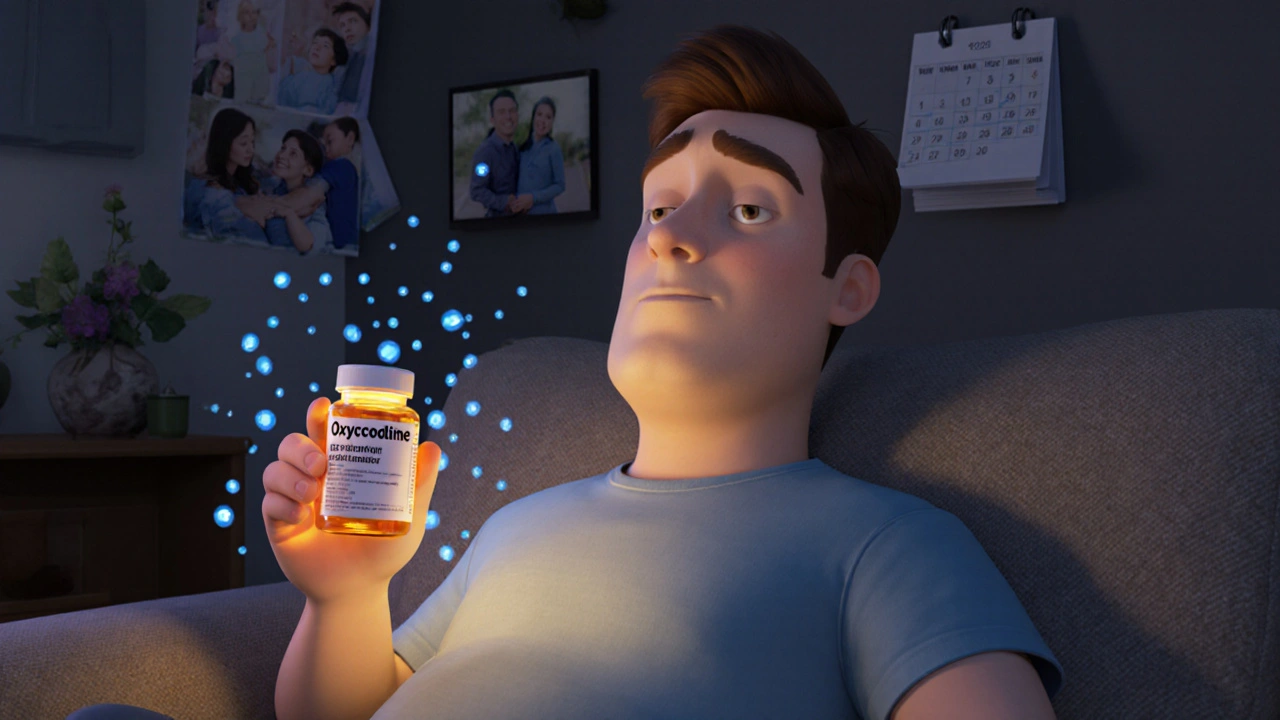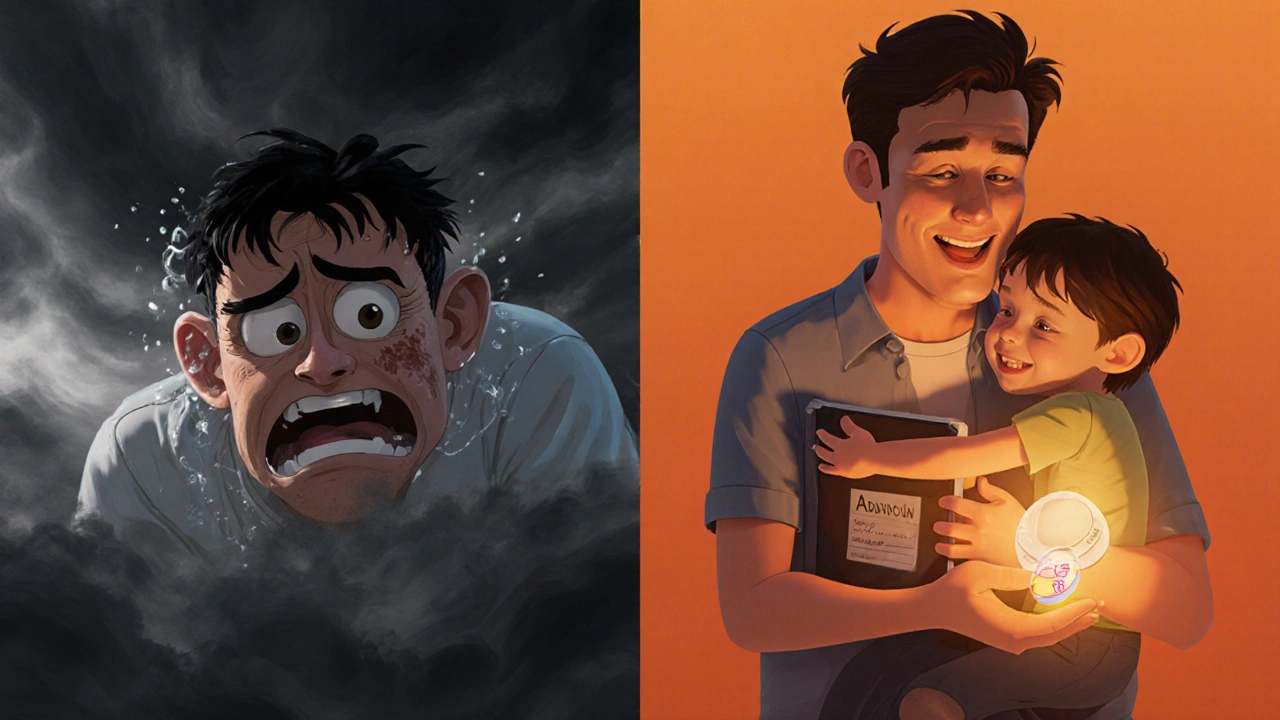Physical Dependence vs Addiction: Understanding Opioid Use Disorder
 Nov, 13 2025
Nov, 13 2025
Physical Dependence vs. Addiction Assessment
This assessment helps you understand if your symptoms relate to physical dependence or opioid use disorder
Physical dependence is a biological adaptation where your body needs the drug to function normally. Addiction (Opioid Use Disorder) involves behavioral patterns like loss of control, cravings, and negative impacts on your life.
Check your symptoms
Many people hear the word addiction and immediately think of someone who can’t stop taking pills. But if you’ve been prescribed opioids for chronic pain, and you suddenly feel sick when you miss a dose, that doesn’t mean you’re addicted. It means your body has adapted. This confusion - between physical dependence and addiction - is costing people their pain relief, their dignity, and sometimes their lives.
What Is Physical Dependence?
Physical dependence happens when your body gets used to having a drug in your system. It’s not a choice. It’s biology. If you take opioids like oxycodone, hydrocodone, or morphine for more than a few weeks, your brain and nervous system adjust. They start relying on the drug to keep things running normally.
When you stop, your body goes into reverse. It’s like hitting the brakes too hard after cruising on the highway. You get withdrawal symptoms: nausea, vomiting, sweating, anxiety, diarrhea, yawning, muscle aches. These aren’t signs of moral failure. They’re signs your nervous system is recalibrating. Studies show that up to 100% of people who take opioids daily for 30 days or more develop this kind of dependence - even if they’re following their doctor’s orders exactly.
It usually starts within 7 to 10 days of regular use, especially at doses over 30 morphine milligram equivalents (MME) per day. Tolerance often comes with it - meaning you need higher doses to get the same pain relief. That’s not addiction. That’s your body learning to ignore the drug’s effects.
Doctors used to call this “dependence” and worry it meant someone was becoming addicted. But that thinking has changed. The DSM-5, the official guide for mental health diagnoses, removed “dependence” as a label in 2013 because it caused so much confusion. Now, we know: dependence ≠ addiction.
What Is Addiction - or Opioid Use Disorder?
Addiction is now called Opioid Use Disorder (OUD) in clinical terms. And it’s not about physical symptoms. It’s about behavior. It’s when someone keeps using opioids even when it’s destroying their life.
The brain changes in OUD are different. It’s not just the nervous system adapting - it’s the reward circuitry that’s broken. The dopamine system, which normally helps you feel pleasure from food, sex, or time with loved ones, gets hijacked. The drug becomes the only thing that feels good. The prefrontal cortex - the part of your brain that makes rational decisions - starts to shut down. You lose control.
The DSM-5 lists 11 symptoms for diagnosing OUD. You need at least two to qualify. These include:
- Craving the drug intensely
- Using more than you planned
- Trying to quit but failing
- Spending hours getting, using, or recovering from the drug
- Neglecting responsibilities at work, school, or home
- Continuing use even when it causes relationship problems
- Giving up hobbies or activities you once loved
- Using in dangerous situations (like driving)
- Needing higher doses to feel the same effect (tolerance)
- Experiencing withdrawal symptoms
- Continuing use despite physical or mental health problems
Here’s the key: someone can have physical dependence without any of these behaviors. But someone with OUD almost always has physical dependence too - because the drug is in their system. But the addiction part? That’s the loss of choice. The compulsion. The shame. The lies. The stealing. The job loss. The isolation.
Only about 8% of people prescribed opioids long-term develop OUD. That’s not a small number - but it’s not the majority. And yet, because of the confusion between dependence and addiction, many people are forced off their meds out of fear.

Why This Confusion Is Dangerous
In 2020, a study found that 68% of chronic pain patients on opioids thought withdrawal symptoms meant they were addicted. That’s why so many quit cold turkey. That’s why some doctors suddenly stop prescriptions, even when the patient is managing pain well.
One patient from Edinburgh told me: “I was on 60 MME a day for years after my knee surgery. When my doctor cut me off, I had two weeks of shaking, sweating, and panic attacks. I didn’t want more pills. I just wanted to feel normal again. But everyone kept saying I was addicted.”
That’s not addiction. That’s dependence. And it’s being treated like a crime.
Meanwhile, people with real OUD are often ignored because they’re seen as “just addicted.” But OUD is a medical condition - not a character flaw. It’s a brain disease. It’s not about willpower. It’s about circuits that no longer respond to normal rewards.
The CDC, the American Medical Association, and the National Institute on Drug Abuse all agree: conflating dependence with addiction leads to undertreated pain, stigma, and even death. People who stop opioids too fast are more likely to turn to heroin or fentanyl. That’s not a coincidence. It’s a consequence.
How Doctors Tell the Difference
There’s no single blood test. But there are tools. The Opioid Risk Tool (ORT) helps doctors spot who might be at higher risk for OUD - things like a history of alcohol or drug misuse, mental health conditions, or family history of addiction. About 24% of patients score as high-risk.
For someone on long-term opioids, doctors watch for signs of behavioral changes. Are they asking for early refills? Are they visiting multiple clinics? Are they lying about lost prescriptions? Are they losing jobs or relationships? Those are red flags for OUD.
For physical dependence, the signs are purely physical. The Clinical Opiate Withdrawal Scale (COWS) measures things like pulse rate, sweating, tremors, and anxiety. A score above 12 means withdrawal is moderate and needs medical support.
And here’s the most important part: physical dependence can be safely managed. A slow taper - reducing the dose by 5% to 10% every 2 to 4 weeks - can help the body adjust without severe symptoms. For people on higher doses (over 100 MME), going even slower - 5% per month - is recommended.
But if someone has OUD? Tapering alone won’t fix it. They need Medication-Assisted Treatment (MAT). That means buprenorphine or methadone - drugs that calm the brain without causing a high - combined with counseling. MAT reduces overdose deaths by 50% to 80%. It’s the gold standard. And yet, only 67% of insurance plans have clear rules for covering it.

What You Should Know If You’re on Opioids
If you’re taking opioids for pain:
- Feeling sick when you skip a dose? That’s your body adjusting. Not addiction.
- Wanting to stop? Talk to your doctor about a taper plan. Don’t quit cold turkey.
- Still able to work, care for your kids, keep up with friends? That’s a good sign.
- Starting to lie, steal, or isolate? That’s a warning.
- Craving the drug even when you’re not in pain? That’s OUD.
And if you’re worried you might be addicted - you’re not alone. But you’re not broken. OUD is treatable. And the first step is understanding the difference.
What’s Changing Now
In 2023, the FDA approved a new drug called lofexidine extended-release to ease opioid withdrawal symptoms. That’s a big deal. It means we’re finally treating dependence as a medical issue - not a moral one.
Researchers are also using brain scans to tell the difference. A 2023 study showed fMRI scans could spot OUD from simple dependence with 89% accuracy by measuring activity in the prefrontal cortex during craving tasks. In the next few years, this could become a routine tool.
And the CDC’s 2022 guidelines now say clearly: “Physical dependence is not a reason to discontinue opioid therapy when benefits outweigh risks.” That’s a shift. A real one.
Still, 35% of patients are misdiagnosed today. That’s one in three people who are either wrongly forced off their meds - or wrongly told they’re addicted when they’re not.
The American Pain Society says we need routine education - for patients and doctors - about this difference. Because if we don’t get this right, people will keep suffering in silence. Or worse - dying because they were afraid to ask for help.
Is physical dependence the same as addiction?
No. Physical dependence means your body has adapted to a drug and will cause withdrawal symptoms if you stop. Addiction - or Opioid Use Disorder - means you can’t control your use despite serious harm to your health, relationships, or job. You can have dependence without addiction. But addiction almost always includes dependence.
Can you become addicted to opioids if you take them as prescribed?
Yes, but it’s rare. About 8% of people who take opioids long-term for pain develop Opioid Use Disorder. Most people - over 90% - take them as directed and never lose control. The bigger risk is physical dependence, which happens in nearly everyone after a few weeks. That’s not addiction.
What are the signs I might have Opioid Use Disorder?
Look for behavioral changes: craving the drug even when not in pain, taking more than prescribed, lying to doctors, missing work or family events, stealing money to buy pills, or using despite health problems. Physical withdrawal alone doesn’t mean you have OUD. But these behaviors do.
If I need to stop opioids, should I quit cold turkey?
No. Quitting suddenly can cause severe withdrawal - vomiting, diarrhea, anxiety, even seizures. Work with your doctor on a slow taper, usually 5-10% reduction every 2-4 weeks. For higher doses, go even slower. Medical support makes this safer and more comfortable.
What treatments are available for Opioid Use Disorder?
Medication-Assisted Treatment (MAT) is the most effective. Buprenorphine and methadone reduce cravings and withdrawal, cutting overdose deaths by 50-80%. These are combined with counseling or therapy. MAT isn’t replacing one drug with another - it’s stabilizing your brain so you can rebuild your life.
Why do some doctors stop opioids suddenly?
Many doctors fear legal or regulatory backlash. They confuse physical dependence with addiction. Some are pressured by insurance or government guidelines. But the CDC now says this is dangerous. Stopping opioids abruptly can push people toward illegal drugs. The right approach is to assess each patient individually - not make blanket rules.
Can physical dependence be reversed?
Yes. Once you stop opioids, withdrawal symptoms usually peak within 72 hours and fade over 1-2 weeks. The brain’s autonomic systems return to normal. Unlike OUD, there are no lasting changes to reward pathways. That’s why tapering works - your body just needs time to readjust.
Is it safe to use opioids for chronic pain?
For some people, yes. The CDC says opioids can be appropriate for chronic pain if benefits outweigh risks. But they should be used at the lowest effective dose, with regular check-ins. For others, non-opioid options like physical therapy, nerve blocks, or antidepressants may be better. The goal isn’t to avoid opioids entirely - it’s to use them wisely.